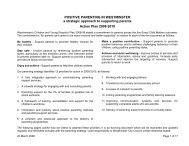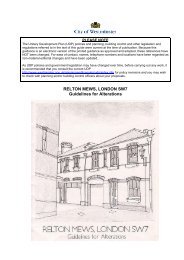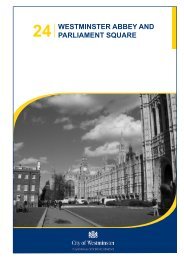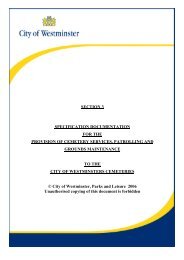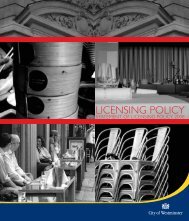Westminster Open Spaces Noise Study 2008 Final Report
Westminster Open Spaces Noise Study 2008 Final Report
Westminster Open Spaces Noise Study 2008 Final Report
- No tags were found...
You also want an ePaper? Increase the reach of your titles
YUMPU automatically turns print PDFs into web optimized ePapers that Google loves.
<strong>Westminster</strong> <strong>Open</strong> <strong>Spaces</strong> <strong>Noise</strong><strong>Study</strong> <strong>2008</strong>: <strong>Final</strong> <strong>Report</strong>“Q. 7 In this space how do you feel? Don't rush to prompts, but if needed - Happy, safe,unsafe, peaceful, nervous, relaxed etc.”This question was asked near the end of the survey, respondents having been given achance to think about the various factors that made up the space. Responses wererecorded as well as ‘tagged’, as before.2.6.5 Due to the time available per site and the thrust of the study towards producing assessmenttoolkits, qualitative responses were given less importance than in a structuredconversational interview format. However, qualitative responses contributed to ourunderstanding of the associations people make with open spaces, various factors presentin them, and their understanding of tranquillity. As a result, the qualitative responses areimplicit in our conclusions and recommendations.2.7 Sampling2.7.1 The sampling method used was convenience sampling (non-probability) as it was reliant onpark users voluntarily taking part in the questionnaire.2.7.2 The questionnaires were conducted at various times of the day between 11:00 and 18:00 atboth weekdays and weekends at 20 different sites. Details of the days when sites werevisited are provided in Appendix C. Due to budgetary constraints, time was limited to 1 hourof research per site.2.7.3 Response numbers were limited at several sites as a result of the fixed time windows inwhich site work had to be undertaken. Scott Wilson originally recommended a minimum ofhalf a day per site, but were asked to prioritise a greater number of site visits within thebudget. Normally, this is a deterrent to the creation of a fully robust toolkit based on useropinion. However, the typology method of producing toolkits, (as explained in 2.10 below)has partially mitigated this circumstance by pooling responses for a number of sites whichfall within the same typology, and using this pooled number to calculate the importance ofeach factor to a sense of tranquillity (see limitations of the method in Section 3.4 for wherewe think this can be improved upon).2.8 Note on Typologies2.8.1 The CPRE study weighted several factors of tranquillity against each other and resulted ina single Toolkit for assessing tranquillity in rural spaces in England. In a central London,distinctly urban environment, the relative importance of individual factors on the tranquillityof a space would vary widely between specific site contexts. Assessing the value of ‘agreen landscape’, for instance, would be irrelevant in paved public spaces such asTrafalgar Square, which may be valued by users for its tranquillity on other counts.Similarly, the question of whether the presence of ‘wide open spaces’ contributes totranquillity would be inapplicable in small pocket parks, which users may still find to be themost tranquil of spaces.2.8.2 WCC has classified these 20 sites into seven typologies based on Greater LondonAuthority land use designations, these are: District, Local Park, Metropolitan, Pocket Park,Small Local Park, Civic Space, Linear <strong>Open</strong> Space.2.8.3 In carrying out the survey, specific similarities between the types of responses - andtherefore the user experience - of sites were found across these typologies. (See also 3.1.3in ‘Creation of Toolkits’). In light of comparative analysis therefore, it was thought useful toconsider:D121316/R1/028Scott Wilson LtdMarch 2009





